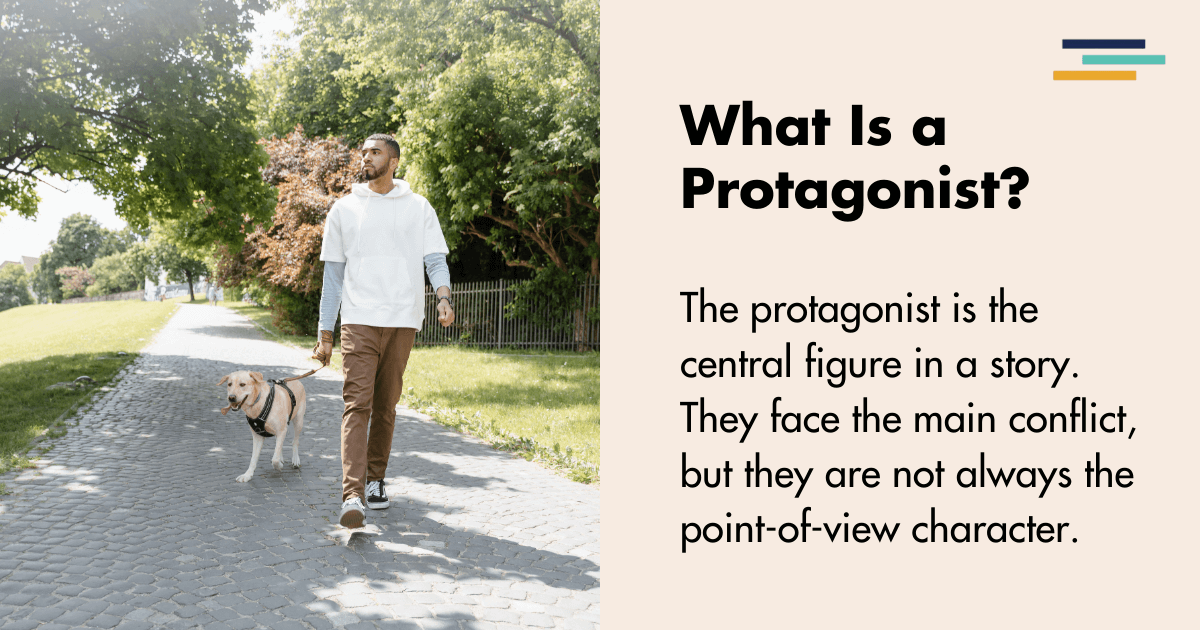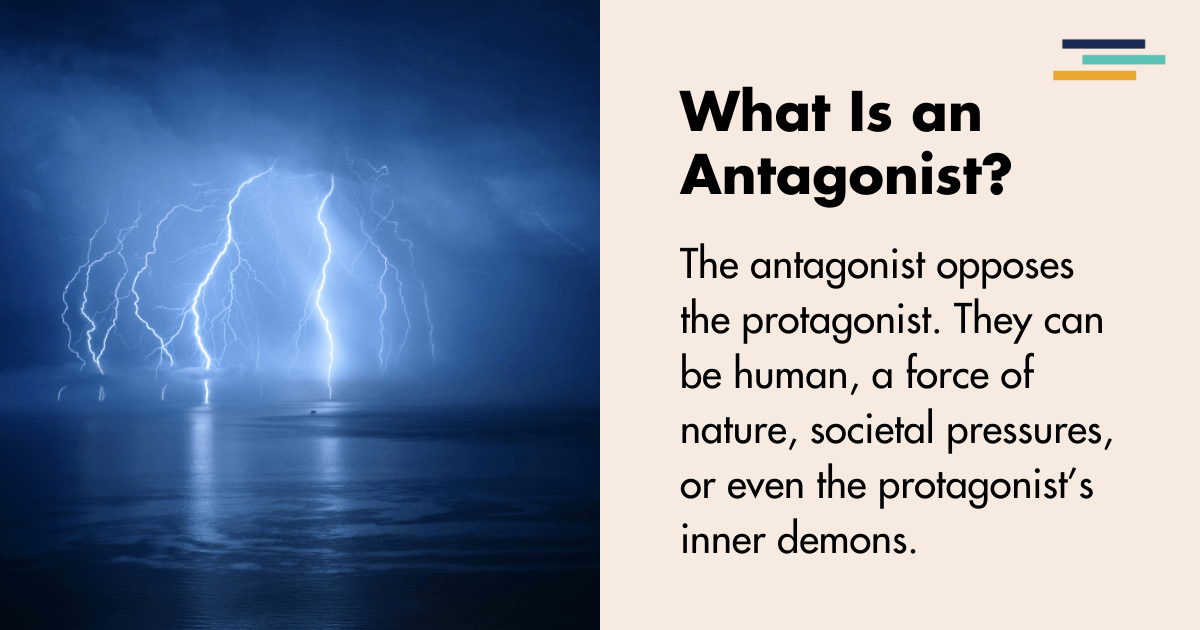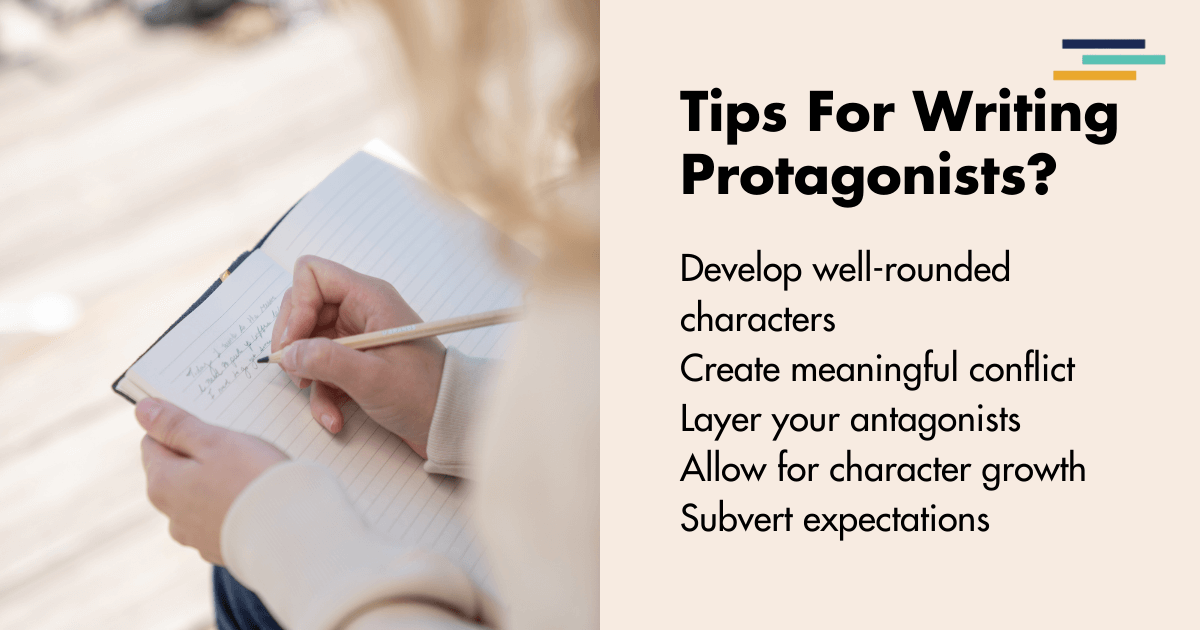
Ever been so hooked on a story that you’re practically fist-pumping for the hero to win? Or maybe you’re muttering, “Ugh, I hate this villain,” but secretly loving every second of their screen time?
Yeah, that’s the magic of the protagonist and antagonist.
By the end of this article, you’ll have a shiny new way to look at your favorite characters, and who knows, maybe you’ll be inspired to create some of your own. Sound good? Let’s pull back the curtain and see what makes these literary heavyweights tick.
Take a free trial of Fictionary today and take your story to the next level.
Who Is the Protagonist and Antagonist?
The protagonist and antagonist are the beating heart of almost every story. Think of them as the yin and yang that keep us up until 3 a.m., muttering, “Just one more chapter…” But what exactly sets them apart? Why do we cheer for one and hope the other gets a swift kick in the metaphorical pants?
Protagonist Definition
Sure, a story might have a whole cast of important characters, but there’s usually one central figure—the protagonist—who stands out as the story’s focus. The protagonist is the star of the show, the one with their name in lights (metaphorically, anyway). The term itself comes from the Greek words “protos” (meaning “first”) and “agonistes” (meaning “actor” or “competitor”). Fancy, right?
But being the protagonist isn’t just about hogging screen time or having the most lines. Protagonists push the plot forward, making choices (good or bad), and facing all the juicy conflicts that keep us hooked. We’re on their journey, riding the emotional rollercoaster right alongside them. Sometimes we’re cheering them on, sometimes we’re yelling at them through the pages or the screen.
Protagonists can be anything from knight-in-shining-armor heroes to hot mess express anti-heroes. Maybe they’re virtuous and noble, or maybe they’re a little rough around the edges—flawed, but somehow, we get them. What unites all protagonists, though, is that they change or grow in some way throughout the story. That’s what we call their character arc.
The protagonist is the one facing the main conflict. That could be an external challenge—like, say, fighting off a villain or saving the world. Or it could be an internal battle—like facing down a deep-seated fear or learning how to trust. Whatever it is, their struggle to resolve this conflict is what keeps us turning the pages or binge-watching the series.
But wait! Here’s where it gets tricky: The protagonist isn’t always the same as the POV (point-of-view) character. Sometimes, the story is told through someone else’s eyes while the protagonist takes center stage in the action. Curious how that works? Don’t worry, we’ve got an example of that coming up later!

Antagonist Definition
The protagonist may be the star of the show, but the antagonist? They’re the reason the show’s even worth watching. The word “antagonist” comes from the Greek “antagonistes” (fancy, huh?), which means “opponent” or “competitor.” In storytelling, the antagonist is the force that opposes the protagonist—creating all that glorious conflict that keeps us hooked.
Now, don’t get it twisted. Not all antagonists are cartoonish villains with twirly mustaches and evil laughs. Sure, some fit that mold (and we love to hate them), but antagonists come in many different forms. They can be complex, misunderstood characters with motivations that actually make sense (or at least kind of).
Sometimes, they’re not even human. They could be forces of nature, societal pressures, or even the protagonist’s own inner demons. Yeah, sometimes we’re our own worst enemy. Fun, right?
The antagonist’s main job is to get in the protagonist’s way. They throw up obstacles, raise the stakes, and basically force the protagonist to step up their game. Without a solid antagonist, your story’s going to feel a little… well, flat. It’s the push-pull between them that keeps the tension high and the story moving.
Oh, and here’s a fun twist—antagonists don’t always see themselves as “the bad guy.” In their mind, they’re doing what’s right, maybe even necessary. This kind of complexity can make for some seriously juicy character dynamics. Moral dilemmas? Yes, please.
Bottom line: a strong antagonist makes a strong story. They’re not just a roadblock for your protagonist to bulldoze through. They’re a critical piece of the narrative puzzle, pushing the protagonist to grow and become the person they need to be.

Examples of Protagonist and Antagonist
Alright, we’ve nailed down what protagonists and antagonists are, but theory is one thing—let’s see how this dynamic actually plays out. Lucky for us, the worlds of literature, film, and TV are bursting with juicy examples. In this section, we’ll cover some classic and contemporary stories to explore how these characters drive their narratives.
Spoiler alert: while the details change from story to story, the core dynamic between protagonist and antagonist is what makes the storytelling magic happen.
Star Wars: Original Trilogy
Let’s kick things off with George Lucas’ classic good-versus-evil story that’s easy to grasp but still oh-so-satisfying.
Protagonist: Luke Skywalker
Luke Skywalker starts out as a wide-eyed farm boy, but by the end of the trilogy, he’s a full-on Jedi Knight. His journey from zero to hero is the backbone of the story, and it’s your classic hero’s journey: young, naive guy gets thrown into an epic conflict, grows, learns, and ultimately saves the galaxy. No big deal.
Antagonist: Darth Vader / The Empire
Darth Vader isn’t just Luke’s opponent—he’s his father. Talk about family drama! Their battle is as much emotional as it is physical, and it makes for some seriously compelling storytelling. On a larger scale, the Galactic Empire represents everything Luke is fighting against: tyranny, oppression, and all-around evil.
Luke’s struggle with Vader isn’t just about lightsaber duels—though those are fun. It’s about wrestling with his own identity, fighting for his father’s redemption, and saving the galaxy from the Empire’s iron grip. The personal and cosmic conflicts weave together beautifully, showing how a protagonist-antagonist relationship can work on multiple levels at once.
To Kill a Mockingbird
Next, let’s move into a more nuanced story with layers of social commentary and a deeper moral struggle: Harper Lee’s To Kill a Mockingbird.
Protagonist: Atticus Finch
Atticus Finch is a straight-up hero. A lawyer, a widower, and a dad, he’s got more integrity in his pinky than most people have in their whole body. When he takes on the case of Tom Robinson, a Black man wrongly accused of rape, he’s fighting the good fight, even though everyone around him is screaming for him to back down.
Antagonist: Racial Prejudice / Bob Ewell
Here’s where it gets interesting. The antagonist isn’t just one person—it’s the entire system of racial prejudice that’s choking the town. Bob Ewell, who falsely accuses Tom, is the face of this ugly force. He’s slimy, petty, and full of hate, but he’s not the only problem. He’s just the tip of the iceberg.
The real battle is bigger than the courtroom. Atticus is up against centuries of deeply ingrained racism. The stakes are high, and the tension between justice and prejudice makes for a story that hits hard and stays with you. Through the eyes of Atticus and his daughter Scout, we get a front-row seat to the moral dilemmas and social issues that still resonate today.
Moby-Dick
Now we’re wading into more ambiguous territory, where the lines between good and bad get blurry.
Protagonist: Captain Ahab
Captain Ahab isn’t your cookie-cutter hero. In fact, “hero” is a stretch. He’s the protagonist because the story revolves around his obsessive quest, but he’s far from admirable. Ahab is what we call an anti-hero—he’s got the spotlight, but let’s be real, he’s a bit… unhinged.
Antagonist: Moby Dick (The White Whale)
This antagonist isn’t even human—Moby Dick, the giant white sperm whale, is the force of nature that Ahab is dead set on destroying. The whale couldn’t care less about Ahab’s vendetta, but that doesn’t stop the captain from spiraling into madness over it.
The whole story is fueled by Ahab’s single-minded pursuit of Moby Dick, born from a previous encounter that left Ahab with a serious grudge. The dynamic between them raises some interesting questions: Is Moby Dick evil, or just… being a whale? Is Ahab noble for sticking to his guns, or just plain nuts? It’s this moral gray area that keeps things spicy.
Through this epic man-versus-nature battle, Melville dives deep (pun intended) into themes of obsession, ambition, and self-destruction.
The Great Gatsby
Finally, we get to F. Scott Fitzgerald’s The Great Gatsby, which throws us a curveball when it comes to the protagonist-antagonist dynamic—and even challenges who’s telling the story.
Protagonist: Jay Gatsby
Jay Gatsby is the ultimate tragic dreamer. He’s clawed his way from poverty to ridiculous wealth, all in the hopes of winning back his old flame, Daisy Buchanan. His life is a glittering facade, but underneath? A man hopelessly stuck in the past. Gatsby’s tragic flaw—his inability to move on—drives the story and makes him one of the most heartbreaking protagonists out there.
Antagonist: Tom Buchanan / The American Dream
Gatsby’s up against more than just Daisy’s husband, Tom Buchanan (who is a real piece of work, by the way). Tom’s got the “old money” status, the arrogance, and the casual cruelty of the upper class. But the real antagonist? The American Dream itself. Gatsby’s been lured in by the idea that money and success can buy happiness and love, but spoiler alert: it can’t.
But here’s a fun twist: Gatsby isn’t the narrator of this story. That role belongs to Nick Carraway, who acts as the POV character while Gatsby takes the lead as the protagonist. It’s an important distinction we talked about earlier—the protagonist may drive the story, but they’re not always the one telling it. Nick gives us an outsider’s perspective on Gatsby’s rise and fall, adding layers of complexity to the whole American Dream illusion.
Sure, the struggle between Gatsby and Tom is a fight over a woman. But more than that, it’s a battle between new money and old, between hope and harsh reality. And in the end, Gatsby’s pursuit of the American Dream leads him to a tragic end, leaving us to question what success really means.
Tips For Writing a Protagonist and Antagonist
Ready to bring your characters to life? Creating a gripping story means crafting a strong protagonist-antagonist dynamic. Here are some key tips to help you write protagonists and antagonists that are complex, compelling, and unforgettable.

Develop Well-Rounded Characters
First things first—ditch the flawless hero and the evil-for-the-sake-of-evil villain. We’ve seen it. It’s flat. Instead, let’s aim for complexity, yeah? Your protagonist needs flaws. Make them messy, vulnerable, maybe a little too stubborn for their own good. And your antagonist? Give them motivations we can almost understand. Sure, they’re standing in the protagonist’s way, but they don’t have to twirl their mustache while doing it.
The goal here is to make both characters feel like real, breathing people (or, you know, whatever species or entities they happen to be). What’s driving them? What are they scared of? What do they secretly wish for? When you answer these questions, your characters start to come alive on the page. The ones that stick with readers are the ones who feel authentic—strengths, weaknesses, and all.
Create Meaningful Conflict
The tension between your protagonist and antagonist should fuel your entire story. It’s not enough for them to just throw shade or glare at each other from across the room. Their goals need to be fundamentally at odds. This is what creates that delicious, page-turning conflict.
Don’t forget, conflict can be both external and internal. Maybe they’re battling for control, survival, or revenge, but under the surface, there’s an emotional or moral struggle too. The best stories weave these two types of conflict together. Maybe the protagonist’s biggest enemy is also their own self-doubt, or the antagonist is pushing all the wrong buttons, exploiting every single flaw. That’s when things get interesting.
Layer Your Antagonists for Extra Drama
Your antagonist doesn’t have to be just one person or thing. In fact, some of the juiciest stories have antagonists that work on multiple levels. Take a look at the examples we’ve explored—like The Great Gatsby, where Tom Buchanan is the clear antagonist, but he also represents the corrupt American Dream. Or To Kill a Mockingbird, where Bob Ewell is the bad guy, but behind him looms the whole system of racial prejudice.
So, when you’re crafting your antagonist, ask yourself: What do they represent? Are they just an obstacle, or are they the embodiment of something more? By adding this extra layer, you’ll create a richer, more compelling narrative that keeps readers thinking long after the story ends. Plus, who doesn’t love a good multi-layered villain?
Allow for Character Growth
No one likes a static character, so make sure your protagonist is evolving as they face off against the antagonist. The obstacles and challenges they encounter should change them in some way, and by the end, we want to see someone who’s learned something (even if it’s learned the hard way).
But hey, don’t leave your antagonist behind! They deserve an arc too. Maybe they’re adapting to each defeat, or maybe their motivations shift as things spiral out of control. An antagonist who grows, even in subtle ways, is way more compelling than one who’s just…there. A villain who learns from their mistakes? Now that’s a problem for your protagonist.
Subvert Expectations
Look, there’s nothing wrong with sticking to classic story structures, but if you really want to keep readers on their toes, don’t be afraid to shake things up. Maybe your protagonist isn’t as squeaky clean as we thought, or your antagonist is working from some surprisingly noble motivations. Gray areas, moral ambiguity—that’s the good stuff.
You could even flip the script and let us see things from the antagonist’s point of view. It humanizes them, makes them more than just the bad guy twirling their mustache in the shadows. Heck, you might even blur the lines so much that we’re not sure who we should be rooting for. Surprise your readers, challenge their assumptions, and you’ll have them hooked until the very last page.
Protagonist and Antagonist Characters Conclusion
By now, it’s clear that protagonists and antagonists are much more than just labels—they’re the driving force behind any great story. Whether it’s Captain Ahab’s obsession with the white whale or the epic battle between Luke Skywalker and Darth Vader, these dynamics create the tension that keeps us hooked.
We’ve seen how these relationships can symbolize personal struggles, societal issues, or even abstract concepts. Understanding how protagonists and antagonists work gives us a deeper appreciation for storytelling and helps writers craft compelling narratives.
But remember, these roles aren’t set in stone. Modern stories often blur the lines, giving us morally complex characters who challenge our expectations. This reflects our own world, where things aren’t always black and white.
So next time you read a story, pay attention to this dynamic. It might just reveal something new about the characters—and maybe even about yourself.


